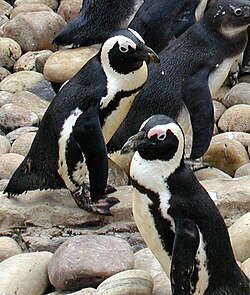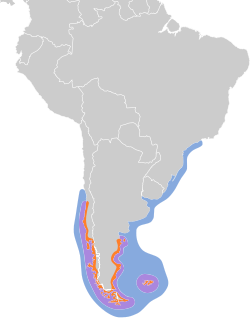| Banded penguin Temporal range: Middle Miocene-Recent | |
|---|---|
 | |
| Spheniscus demersus, the African penguin | |
| Scientific classification | |
| Kingdom: | Animalia |
| Phylum: | Chordata |
| Class: | Aves |
| Order: | Sphenisciformes |
| Family: | Spheniscidae |
| Genus: | Spheniscus Brisson, 1760 |
| Type species | |
| Diomedea demersa [1] Linnaeus, 1758 | |
| Species | |
The banded penguins are penguins that belong to the genus Spheniscus. There are four living species, all with similar banded plumage-patterns. They are sometimes also known as "jack-ass penguins" due to their loud locator-calls sounding similar to a donkey braying. [2] Common traits include a band of black that runs around their bodies bordering their black dorsal coloring, black beaks with a small vertical white band, distinct spots on their bellies, and a small patch of unfeathered or thinly feathered skin around their eyes and underdeveloped fluff sack that can be either white or pink. All members of this genus lay eggs and raise their young in nests situated in burrows or in natural depressions in the earth. [3] [4]












